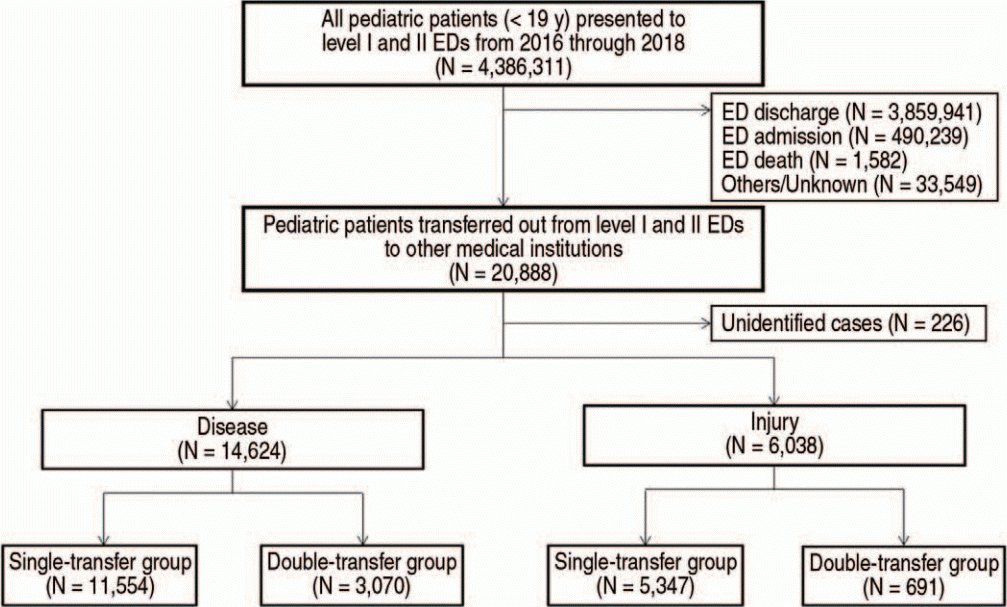1. American Academy of Pediatrics, Committee on Pediatric Emergency Medicine; American College of Emergency Physicians, Pediatric Committee; Emergency Nurses Association, Pediatric Committee. Joint policy statement--guidelines for care of children in the emergency department. J Emerg Nurs. 2013; 39:116–31.
2. Basco WT, Rimsza ME; Committee on Pediatric Workforce; American Academy of Pediatrics. Pediatrician workforce policy statement. Pediatrics. 2013; 132:390–7.
3. Bennett CL, Espinola JA, Sullivan AF, Boggs KM, Clay CE, Lee MO, et al. Evaluation of the 2020 pediatric emergency physician workforce in the US. JAMA Netw Open. 2021; 4:e2110084.
4. Schmitz GR. addressing shortages in pediatric emergency care-the evolution of health care access. JAMA Netw Open. 2021; 4:e2110115.
5. Cushing AM, Bucholz E, Michelson KA. Trends in regionalization of emergency care for common pediatric conditions. Pediatrics. 2020; 145:e20192989.
6. Li J, Monuteaux MC, Bachur RG. Interfacility transfers of noncritically ill children to academic pediatric emergency departments. Pediatrics. 2012; 130:83–92.
7. Huff AN, Keeperman JB, Osborn L. Chapter 74. Interfacility transportation. In: Cone DC, Brice JH, Delbridge TR, Myers JB, editors. Emergency medical services: clinical practice and systems oversight. 3rd ed. John Wiley & Sons, Inc.; 2021. p. 50-7.
8. Hernandez-Boussard T, Davies S, McDonald K, Wang NE. Interhospital facility transfers in the United States: a nationwide outcomes study. J Patient Saf. 2017; 13:187–91.
9. Mueller S, Zheng J, Orav EJ, Schnipper JL. Interhospital transfer and patient outcomes: a retrospective cohort study. BMJ Qual Saf. 2019; 28:e1.
10. Mohr NM, Harland KK, Shane DM, Miller SL, Torner JC. Potentially avoidable pediatric interfacility transfer is a costly burden for rural families: a cohort study. Acad Emerg Med. 2016; 23:885–94.
11. Golestanian E, Scruggs JE, Gangnon RE, Mak RP, Wood KE. Effect of interhospital transfer on resource utilization and outcomes at a tertiary care referral center. Crit Care Med. 2007; 35:1470–6.
12. Barry PW, Ralston C. Adverse events occurring during interhospital transfer of the critically ill. Arch Dis Child. 1994; 71:8–11.
13. Chaichotjinda K, Chantra M, Pandee U. Assessment of interhospital transport care for pediatric patients. Clin Exp Pediatr. 2020; 63:184–8.
14. Kim YJ, Hong JS, Hong SI, Kim JS, Seo DW, Ahn R, et al. the prevalence and emergency department utilization of patients who underwent single and double inter-hospital transfers in the emergency department: a nationwide population-based study in Korea, 2016-2018. J Korean Med Sci. 2021; 36:e172.
15. Lim T, Park J, Je S. Pediatric Korean Triage and Acuity Scale. Pediatr Emerg Med J. 2015; 2:53–8. Korean.
16. Han KS, Jeong J, Kang H, Kim WY, Kim SJ, Lee SW. Association between the emergency department length of stay time and in-hospital mortality according to 28 diagnosis groups in patients with severe illness diagnosis codes. J Korean Soc Emerg Med. 2021; 32:77–88. Korean.
17. Nacht J, Macht M, Ginde AA. Interhospital transfers from U.S. emergency departments: implications for resource utilization, patient safety, and regionalization. Acad Emerg Med. 2013; 20:888–93.
18. Kocher KE, Meurer WJ, Desmond JS, Nallamothu BK. Effect of testing and treatment on emergency department length of stay using a national database. Acad Emerg Med. 2012; 19:525–34.
19. Gupta R, Greer SE, Martin ED. Inefficiencies in a rural trauma system: the burden of repeat imaging in interfacility transfers. J Trauma. 2010; 69:253–5.
20. Fenton SJ, Lee JH, Stevens AM, Kimbal KC, Zhang C, Presson AP, et al. Preventable transfers in pediatric trauma: a 10-year experience at a level I pediatric trauma center. J Pediatr Surg. 2016; 51:645–8.
21. Peebles ER, Miller MR, Lynch TP, Tijssen JA. Factors associated with discharge home after transfer to a pediatric emergency department. Pediatr Emerg Care. 2018; 34:650–5.
22. Lieng MK, Marcin JP, Dayal P, Tancredi DJ, Swanson MB, Haynes SC, et al. Emergency department pediatric readiness and potentially avoidable transfers. J Pediatr. 2021; 236:229–237.e5.
23. Rosenthal JL, Hilton JF, Teufel RJ 2nd, Romano PS, Kaiser SV, Okumura MJ. Profiling interfacility transfers for hospitalized pediatric patients. Hosp Pediatr. 2016; 6:345–53.
24. Min HS, Sung HK, Choi G, Sung H, Lee M, Kim SJ, et al. Operation of national coordinating service for interhospital transfer from emergency departments: experience and implications from Korea. BMC Emerg Med. 2023; 23:15.




 PDF
PDF Citation
Citation Print
Print




 XML Download
XML Download